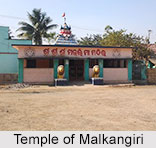 Malkangiri is a town and a Notified Area Council (NAC) in Malkangiri district of Odisha. It is the headquarters of the Malkangiri district. Malkangiri is the new home of the Bangladeshi refugees, who were rehabilitated since 1965 under the Dandakaranya Project. Malkangiri has the ample opportunities of tourism, but the lack of infrastructure delays every project in this area to foster tourism. For the electricity, a dam is constructed, which is now the major tourist attraction in this region of Odisha.
Malkangiri is a town and a Notified Area Council (NAC) in Malkangiri district of Odisha. It is the headquarters of the Malkangiri district. Malkangiri is the new home of the Bangladeshi refugees, who were rehabilitated since 1965 under the Dandakaranya Project. Malkangiri has the ample opportunities of tourism, but the lack of infrastructure delays every project in this area to foster tourism. For the electricity, a dam is constructed, which is now the major tourist attraction in this region of Odisha.
Location of Malkangiri
Malkangiri got its identity as an independent district due to reorganisation of districts of Odisha as per notification on 1st October, 1992 with effect from 2nd October 1992, with an area of 5,791 sq.kms and lies between 17 degree and 45 minutes North to 18 degree 40 minutes North latitudes and 81 degree 10 minutes East to 82 degrees 00 minutes East longitude.
Geography of Malkangiri
Malkangiri is divided into two distinct physical divisions. The eastern part is covered with steep Ghats, Plateaus, Valleys sparsely inhabited by primitive tribes notable among whom are Bondas, Koyas, Porajas and Didayis. The rest of Malkangiri is comparatively flat plain broken by a number of rocky wooded hills.
Demography of Malkangiri
Malkangiri had a population of 31,007. Males constitute 52% of the population and females 48%.
Education of Malkangiri
Malkangiri has an average literacy rate of 57%, lower than the national average of 59.5%: male literacy is 65%, and female literacy is 48%. In Malkangiri, 15% of the population is under 6 years of age.
Administration of Malkangiri
Malkangiri is administered by the current MLA from Malkangiri Assembly (ST) Constituency Manas Kumar Madkami of BJD, who won the seat in 2014. Previous MLAs from this seat were Arabinda Dhali of BJP in 2000 and in 1995, Naka Kanaya who won it for JD in 1990 and for JNP in 1977, Nadiabasi Biswas of INC in 1985, Naka Laxmaya of INC(I) in 1980.
Tourism in Malkangiri
Malkangiri has the ample number of tourist opportunities because of the presence of natural vegetation, forests and rivers. Balimela, Bonda Hills, Ammakunda, Motu, Satiguda Dam, Manyamkonda, Bhairavi Temple are the tourist attractions in this township area in Odisha.
Related Articles
Temples of Odisha
Odisha, Indian state
Nature Tourism in Odisha
Orissa Cuisine



















